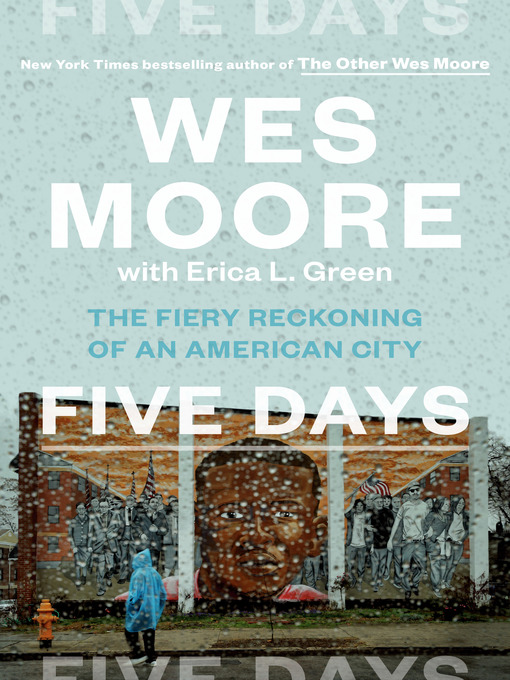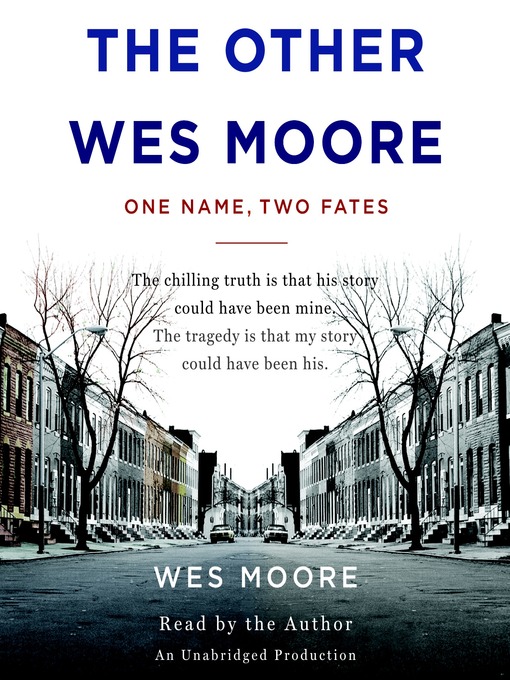by Lisa Greenhouse, Librarian

by Wes Moore with Erica L. Green
Book|ebook|Audiobook
Wes Moore’s and Erica L. Green’s Five Days: The Fiery Reckoning of an American City (One World, 2020) introduces us to nine Baltimoreans in the period following Freddie Gray’s death in police custody on April 19, 2015. There is John Angelos, Executive Vice President of the Baltimore Orioles, who is tasked with making decisions about whether and how to play baseball in the midst of civil unrest. There is Greg Butler, former Poly basketball star, whose decision-making about how to express his anger is at a critical point commandeered by that very anger.
Each short chapter is headed by the name of one of the nine people. The names alternate throughout the book’s length, disappearing then returning as the days unfold. There is Tawanda, an elementary school teacher, who has for two years protested her brother Tyrone West’s death at the hands of the Baltimore Police alone or mostly alone until joining forces with the Freddie Gray protestors. And there is Anthony, a longtime manager of the Shake & Bake roller skating rink in Penn North, who watches the uprising unfold and draw in several of the young men he has mentored.
Jenny is a juvenile court public defender, who monitors the protests and provides legal assistance to those arrested. Maj. Marc Partee of the Baltimore Police is assigned to protect the Inner Harbor on April 25 and to protect Mondawmin Mall two days later on the night of Gray’s funeral.
There is Billy Murphy, attorney and scion of the Baltimore family that founded the Afro-American newspaper, who represents the Gray Family in their suit against the Baltimore Police. And finally, there is Nick Mosby, a Baltimore City Council member, who represents the district where Freddie Gray lived and died.
The racial geography of Baltimore is often compared to a butterfly. The butterfly’s body correlates with the affluent, mostly white center running from Federal Hill north to Homeland and the butterfly’s wings correlate with the under-resourced, largely Black, formerly redlined east and west sides. Unfortunately for the people who live there, those wings mostly don’t fly. Moore and Green take us to the wings and to people from the body who have made a commitment to the wings.
On April 25th, while Orioles fans and protesters are clashing outside of the stadium, John Angelos tweets a call for racial justice. Nick Mosby, after graduating with a B.S. in electrical engineering from Tuskegee University, could have moved anywhere but convinced his wife, Baltimore’s future States Attorney, also a Tuskegee graduate, to move with him back to the Baltimore he loves. During the uprising, Nick frantically tweets out positive pictures he takes of Baltimore, convinced that the media will concentrate on scenes of violence and destruction, painting an unrealistic picture. Still, worried about their safety, Mosby sends his daughters out of town.
Like Mosby, many of the people in Five Days must confront contradictions. Jenny who is a white ally, in the midst of the chaos ensuing on April 27 in Penn North, drops her cellphone. A young African-American man picks it up. Worried that she will lose years of contacts and notes, she begs him to give it back to her. The young man asks her simply, “You thought I wouldn’t?” Jenny, thus, is brought face to face with her unconscious expectations.
The most compelling character in Five Days is Greg Butler. Though having grown up in difficult and unstable circumstances, Greg excelled in school, was admitted to the Polytechnic Institute, and became a high school basketball star. He almost made it off the butterfly’s wing but not quite. A peculiarity in the way that weighted GPA was calculated in Baltimore City put an end to his college aspirations as he scored a hair under the GPA necessary to join the NCAA.
On April 27, from a starting point in East Baltimore, Greg follows the smoke he sees rising across town to the heart of the uprising in Penn North. There, dawning a gas mask and borrowing a bicycle, he takes a leadership role in the uprising. But a split-second decision, which he later regrets, introduces him to the Baltimore legal system. His life seems always at the mercy of small increments in a way that people on the butterfly’s body aren’t.
If you are interested in Five Days, you might also be interested in The Other Wes Moore (Spiegel & Grau, 2010), Wes Moore’s story of his own upbringing in Baltimore and The Bronx. The Maryland Department carries those books and more.
